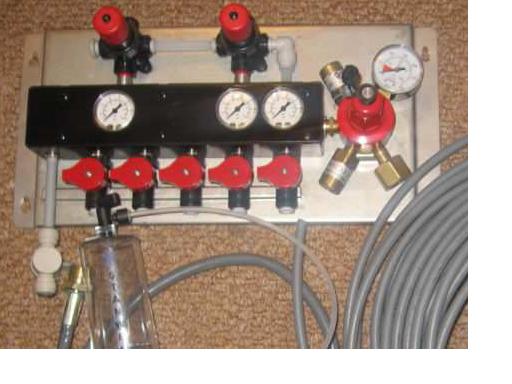peebee
Out of Control
I've been making a nuisance of myself on "another" forum and thought I should share some conclusions about regulators. As I know I'm not the only forum itinerant around here, sorry if you've already read much of it.
I'd been looking into the classy and lightweight aquarium CO2 equipment as a suitable alternative to the clunky heavyweight "welders" equipment many of us use. And the aquarium bunch are very particular about using "dual stage" regulators over "single stage" ones because "single stage" ones have a habit of killing all their fish. I'd come across this before and gave it little thought, after all I already use primary and low pressure secondary regulators (like LPG regulators): Primary, Secondary, ... Single, Dual, ... going to be the same thing? No, completely different.
A look at the regulators we (as brewers) use concluded they are all (cheap) single stage regulators. Now single stage regulators have a feature such that when pressure in the cylinder drops then output pressure INCREASES! Not by much perhaps, 20-30%? I think how much depends on other characteristics, but if input pressure drops enough some regulators can completely fail. This is known as an "End of Tank Dump", and it kills fish!
We are fortunate in using CO2 which forms a liquid so pressure is fairly constant over the life of a cylinder (8-900PSI), it only starts to drop when the liquid is all gone (time for a new fill... quick). And I don't think there are serious implications for us using "single stage" regulators (certainly not heard of any). There is an easy to understand explanation on Wikipedia: https://en.wikipedia.org/wiki/Pressure_regulator.
It's worth getting an understanding to answer all sorts of niggles, like: Why are these "welders" regulators all over the place when trying to set close pressures? Why are regulators that claim to be more accurate that bit more expensive and keep describing themselves as "dual stage"? What are the hazards of dirt in a single stage regulator? (Answer to latter might well be: Boom!).
I'm immune to "end of tank dump" because I use secondary regulators, but the knowledge convinced me to get a 75PSI relief valve for the intermediate section (gas lines between main - primary - regulator and the low pressure secondary regulators). Dual-stage regulators have such PRVs as part of them.
We're happy having these "bombs" about the house, its worth understanding them a bit more.
I'd been looking into the classy and lightweight aquarium CO2 equipment as a suitable alternative to the clunky heavyweight "welders" equipment many of us use. And the aquarium bunch are very particular about using "dual stage" regulators over "single stage" ones because "single stage" ones have a habit of killing all their fish. I'd come across this before and gave it little thought, after all I already use primary and low pressure secondary regulators (like LPG regulators): Primary, Secondary, ... Single, Dual, ... going to be the same thing? No, completely different.
A look at the regulators we (as brewers) use concluded they are all (cheap) single stage regulators. Now single stage regulators have a feature such that when pressure in the cylinder drops then output pressure INCREASES! Not by much perhaps, 20-30%? I think how much depends on other characteristics, but if input pressure drops enough some regulators can completely fail. This is known as an "End of Tank Dump", and it kills fish!
We are fortunate in using CO2 which forms a liquid so pressure is fairly constant over the life of a cylinder (8-900PSI), it only starts to drop when the liquid is all gone (time for a new fill... quick). And I don't think there are serious implications for us using "single stage" regulators (certainly not heard of any). There is an easy to understand explanation on Wikipedia: https://en.wikipedia.org/wiki/Pressure_regulator.
It's worth getting an understanding to answer all sorts of niggles, like: Why are these "welders" regulators all over the place when trying to set close pressures? Why are regulators that claim to be more accurate that bit more expensive and keep describing themselves as "dual stage"? What are the hazards of dirt in a single stage regulator? (Answer to latter might well be: Boom!).
I'm immune to "end of tank dump" because I use secondary regulators, but the knowledge convinced me to get a 75PSI relief valve for the intermediate section (gas lines between main - primary - regulator and the low pressure secondary regulators). Dual-stage regulators have such PRVs as part of them.
We're happy having these "bombs" about the house, its worth understanding them a bit more.







